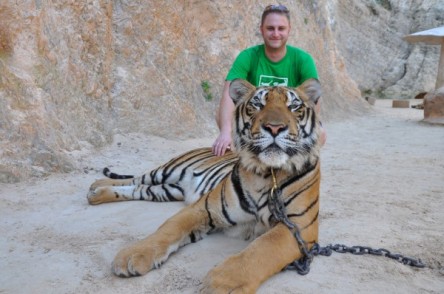What do you think when you read the title? If you think the title doesn’t make sense, then this article is probably not for you. But if you think the title suits you, then this article is definitely for you and you should read it till the end.
If you travel to Asia, chance is you’ll see cute baby animals, dressed in cute clothing and mostly available as photo props. If you show big interest and say “Cuteness overload! I wanna buy one! I wanna keep one at home!”, sometimes they can be sold as a pet to you instantly. Nobody denies that baby animals are so cute and adorable. They are tiny, fluffy and super cute. Once you cuddle them, you fall in love with them and decide to keep one as a pet. If you love animals of course you want to do your best for them. There’s no way you want to hurt those cute baby animals, correct? Now the question is, what’s the best thing you can do for the babies? So here are a few options of what you can do to show your love and care for captured baby animals:
1. Pose for pictures with them. Have you ever wondered how the baby animals ended up as a photo prop? Most babies are obtained from the wild, and the easiest way to catch a baby animal is to kill its mother. I won’t give lengthy explanation about this topic here but you can read more about animals and photo props here. Think twice before you pose pictures with baby animals. Is the suffering in their lives worth for your social media picture?

2. Keep them as pet. So you fall in love with them and decided to keep one as a pet. Suddenly they are sick, maybe because their diet is not as good and not as natural as what they eat in the wild. Because you love them, of course you take them to the vet. No matter how expensive the bills will be, you are willing to save your beloved baby. Now what happens next at the vet? Your vet looks confused because they haven’t seen this animal before. They are not sure what to do with your baby. Oh, wait… They know someone who can help and ask you to wait for a minute. As a wildlife vet I have numerous experience of being called by other vet colleagues saying they have this unusual patient that looks like a wild cat, or like a kind of monkey, or a kind of bird, or even a kind of alien. Here’s the real situation: Some vets can’t even identify the animal species, leave alone diagnosing what common diseases the animals could possibly have. This inability restricts them from giving the right treatment, in addition to they don’t know what drugs can or cannot be used in those exotic animals. Worse, some even cannot handle the patient for a thorough exam because the animals are aggressive, which is normal because they are wildlife and are not meant to be tamed. I don’t blame the vets for not being able to check the patient because most vet schools don’t teach about wildlife subjects in details. I blame the owner for keeping illegal wildlife.
3. Cuddle them every day. They are so cute! You want to spend every possible second with them. You carry them everywhere, you show your best friends and they envy you, you eat with them, you sleep with them. It’s easy to control baby animals, but days after days, weeks after weeks, it does not take long to show their true wild behavior. What used to be cuddly baby turns to be a feisty kinkajou, a bity loris and a scratchy leopard cat. You can’t cuddle them anymore. So what happens next? Remove their claws and their teeth even though it means you’re hurting them? Wait a minute, you don’t want to hurt them, do you? But at the same time you can’t cuddle and play with aggressive animals too. Well, then the message is clear. Don’t buy exotic pets from the very beginning.

Further read: http://www.onegreenplanet.org/animalsandnature/ridiculous-reasons-people-give-for-keeping-exotic-animals-as-pets




